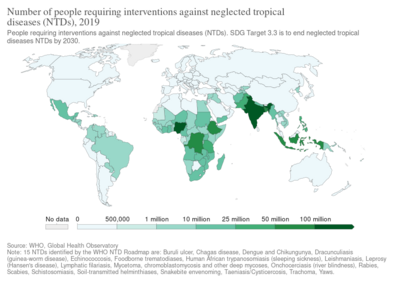Neglected tropical diseases
| Neglected tropical diseases | |
|---|---|
| Other names: Chronic pandemic[1] | |
 | |
| Clinical presentation of skin NTDs. (A & B) Leprosy (C) Lymphatic filariasis (D & E) Leishmaniasis (F) Mycetoma (G) Buruli ulcer (H) Yaws (I) Tungiasis[2] | |
| Specialty | Infectious diseases |
| Types |
|
| Risk factors | Poverty[1] |
| Frequency | >1 billion, mostly in low and middle income countries[3] |
| Deaths | 200,000/year[4] |
Neglected tropical diseases (NTDs) are a diverse group of tropical infections in mainly developing regions of the tropics, that affect generally low-income populations and a disproportionate number of women and children.[3][5] These diseases have a significant impact on health, society and economy, and are considered of "global public health importance".[3][5] The World Health Organization (WHO) list 20 NTDs, while PLOS Neglected Tropical Diseases, supporting the WHO, include additional tropical diseases.[5]
NTDs are caused by a variety of organisms such as viruses, bacteria, protozoa and parasitic worms.[5] Several are vector-borne or have animal reservoirs.[3] Managing NTDs includes prevention, individual treatments, vector control, public health in veterinary medicine, and water, sanitation and hygiene (WASH).[6]
NTDs are contrasted with the big three infectious diseases (HIV/AIDS, tuberculosis, and malaria), which generally receive greater treatment and research funding.[7] In sub-Saharan Africa, the effect of these diseases as a group is comparable to malaria and tuberculosis.[8] NTD co-infection can also make HIV/AIDS and tuberculosis more deadly.[1] Within developed countries, neglected tropical diseases affect the very poorest in society.[9] In the United States, there are up to 1.46 million families including 2.8 million children living on less than two dollars a day.[10] In countries such as these, the burdens of neglected tropical diseases are often overshadowed by other public health issues. However, many of the same issues put populations at risk in developed as developing nations. For example, other problems can stem from poverty which expose individuals to the vectors of these disease, such as lack of adequate housing.[11]
In some cases, the treatments are relatively inexpensive. For example, the treatment for schistosomiasis is US$0.20 per child per year.[12] Nevertheless, in 2010 it was estimated that control of NTDs would require funding of between US$2 billion and US$3 billion over the subsequent five to seven years.[13] Some pharmaceutical companies have committed to donating all the drug therapies required, and mass drug administration (for example, mass deworming) has been successfully accomplished in several countries.[14] However, preventive measures are often more accessible in the developed world, but not universally available in poorer areas.[15]
These diseases are common in 149 countries, affecting more than 1.4 billion people (including more than 500 million children)[16] and costing developing economies billions of dollars every year.[17] Globally they cause 200,000 deaths per year.[4] Of these 20, two were targeted for eradication (dracunculiasis (guinea-worm disease) by 2015 and yaws by 2020), and four for elimination (blinding trachoma, human African trypanosomiasis, leprosy, and lymphatic filariasis) by 2020.[17]
The term was coined by Peter Hotez and colleagues in 2003.[1] The first NTDs were long-term debilitating parasitic infections.[5] Chromoblastomycosis and other deep mycoses, scabies and other ectoparasites and snakebite envenomation were added to the list in 2017.[18]
Reasons for neglect
The importance of neglected tropical diseases has been underestimated since many are asymptomatic and have long incubation periods. The connection between a death and a neglected tropical disease that has been latent for a long period of time is not often realized.[19] Areas of high endemicity are often in geographically isolated areas, making treatment and prevention much more difficult.[20]
These diseases have been overlooked because they mainly affect the poorest countries of the developing world and because of recent emphasis on decreasing the prevalence of HIV/AIDS, tuberculosis, and malaria.[21] Far more resources are given to the "big three" diseases (HIV/AIDS, malaria, and tuberculosis) because of their higher mortality and public awareness rates. Neglected tropical diseases do not have a prominent cultural figure to champion the cause.[20][22]
Stigma
Additionally, neglected tropical diseases are often associated with some kind of social stigma, making their treatment more complex. Public health research has only recently begun to focus on stigma as a component of the issue. From the 1960s onward, approximately one citation a year related to social stigma. In 2006, there were 458.[23] Disease control is greatly affected by this stigma, as it decreases help-seeking and treatment adherence.[24] Disease control programs, starting as early as the 1980s, have begun to integrate stigma mitigation into their offerings. In India, the leprosy program prioritized the message that "leprosy is curable, not hereditary" in order to inspire optimism in highly affected communities. The goal was to make leprosy a disease "like any other", so as to reduce stigma. At the same time, medical resources available in the area were optimized in order to fulfill the curable promise made.[23]
Economic incentives
One reason for neglect for these diseases is that they are not commercial and consequently patents and profit play no role in stimulating innovation. Like all non-commercial areas, these diseases are the responsibility of governments and philanthropy (including industry philanthropy).[25] Currently, the pharmaceutical industry views research and development as highly risky. For this reason, resources are not often put into the field of NTDs (as diseases of the poor) and new chemical products are often expensive. A review of public and private initiatives found that of the 1393 new chemical products that were marketed in the period of 1975 and 1999, just 16 related to tropical diseases and tuberculosis. The same review additionally found that there was a 13-fold greater chance of a drug entering the market being for central-nervous-system disorders and cancer than an NTD.[26]
Due to lack of incentive in the pharmaceutical industry, successful NTD treatment programs have often relied on the donation format. The Mectizan Donation Program has donated over 1.8 billion tablets of ivermectin.[27] While often developed countries will rely on government-run and private partnerships to fund such projects, developing nations frequently have significantly lower per head per annum spending on these diseases.[26]
A 2006 report found that the Gates Foundation funded most extra activity to counter these diseases.[28][29]
Developed nations
Since 2008 the concept of "neglected diseases of poverty" has been developed and explored.[30] This group overlaps with the neglected tropical diseases, which also pose a threat to human health in developed nations. In the United States alone, there are at least 12 million people suffering from these neglected parasitic infections.[30] They make up a hidden disease burden among the poorest of wealthy societies.[15] In developed nations, lack of knowledge in the healthcare industry and lack of conclusive diagnostic tests perpetuate the neglect of this group of diseases.[31]
In the United States, high rates of parasitic infection can be distributed along geographic, racial, and socio-economic lines. Within the African-American community, there may be up to 2.8 million cases of toxocariasis. Rates of toxocariasis, trichomoniasis, and other neglected infections occur in the United States at the same rate as in Nigeria. Within the Hispanic community, neglected infections are concentrated near the US–Mexico border. Vector-borne illnesses are especially high, with some rates approaching those of Latin America. Chagas disease was found in the US as early as the 1970s.[32] However, in the developed world, diseases that are associated with poverty are often not addressed comprehensively. This may be due to lack of economic incentives and public policy failings. Here, a lack of awareness prevents effective policy generation and leaves health care services unequipped to address the issue. Additionally, there is little effort put into taking and maintaining large data sets on neglected disease in the United States and other developed nations. The first summit on the issue was held by the Adler Institute on Social Exclusion in the United States in 2009.[15]
In Europe, a similar trend is seen. Neglected tropical diseases are concentrated in eastern and southern Europe, where poverty levels are the highest. The most prevalent diseases in this region are ascariasis, trichuriasis, zoonotic helminth infections, and visceral leishmaniasis. Migration paths to Europe, most notably to Spain, have brought diseases to Europe as well. As many as 6,000 cases of Chagas disease have been introduced via this method. In response to a growing awareness to the burden on these populations, the European Centre for Disease Prevention and Control has laid out ten public health guidelines. They cover a variety of topics, from health education and promotion to community partnerships and the development of a minority healthcare workforce.[15]
List of diseases
There is some debate among the WHO, CDC, and infectious disease experts over which diseases are classified as neglected tropical diseases. Feasey, a researcher in neglected tropical diseases, notes 13 neglected tropical diseases: ascariasis, Buruli ulcer, Chagas disease, dracunculiasis, hookworm infection, human African trypanosomiasis, Leishmaniasis, leprosy, lymphatic filariasis, onchocerciasis, schistosomiasis, trachoma, and trichuriasis.[21] Fenwick recognizes 12 "core" neglected tropical diseases: the same as above, excluding hookworm.[19]
These diseases result from four different classes of causative pathogens: (i) protozoa (for Chagas disease, human African trypanosomiasis, leishmaniases); (ii) bacteria (for Buruli ulcer, leprosy, trachoma, yaws), (iii) helminths or metazoan worms (for cysticercosis/taeniasis, dracunculiasis, echinococcosis, foodborne trematodiases, lymphatic filariasis, onchocerciasis, schistosomiasis, soil-transmitted helminthiasis); and (iv) viruses (dengue and chikungunya, rabies).[citation needed]
The World Health Organization recognizes the twenty diseases below as neglected tropical diseases.[33]
Buruli ulcer
Buruli ulcer is caused by the bacterium Mycobacterium ulcerans.[37] It is related to the family of organisms that cause tuberculosis and leprosy, but Mycobacterium ulcerans produces a toxin, mycolactone, that destroys tissue.[37] The prevalence of Buruli ulcer is unknown.[21] The risk of mortality is low, although secondary infections can be lethal.[38] Morbidity takes the form of deformity, disability, and skin lesions, which can be prevented through early treatment and treated with antibiotics and surgery.[38] It is found in Africa, Asia, and Latin America.[39]
Chagas disease
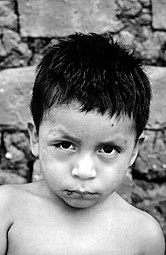
Chagas disease is also known as American trypanosomiasis. There are approximately 15 million people infected with Chagas disease.[21] The chance of morbidity is higher for immuno-compromised individuals, children, and elderly, but very low if treated early.[40] Chagas disease does not kill victims rapidly, instead causing years of debilitating chronic symptoms. It is caused by a vector-borne[41] protozoa[40] and spread by contact with Trypanosoma cruzi infected feces of the triatomine (assassin) bug. The protozoan can enter the body via the bug's bite, skin breaks, or mucous membranes. Infection can result from eating infected food and coming into contact with contaminated bodily fluids.[40] There are two phases of Chagas disease. The acute phase is usually asymptomatic. The first symptoms are usually skin chancres, unilateral purplish orbital oedema, local lymphoadenopathies, and fever accompanied by a variety of other symptoms depending on infection site.[40] The chronic phase occurs in 30 percent of total infections[21] and can take three forms, which are asymptomatic (most prevalent), cardiac, and digestive lesions.[40]
Chagas disease can be prevented by avoiding insect bites through insecticide spraying, home improvement, bed nets, hygienic food, medical care, laboratory practices, and testing.[40] It can also be treated with medication, although these may have severe side effects.[40] It can be diagnosed through a serological test, although the test is not very accurate.[21]
Dengue and chikungunya
There are 50–100 million dengue virus infections annually.[42] Dengue fever is usually not fatal, but infection with one of four serotypes can increase later susceptibility to other serotypes, resulting in a potentially fatal disease called severe dengue.[42] Dengue fever is caused by a flavivirus, and is spread mostly by the bite of the Aedes aegypti mosquito.[42] No treatment for either dengue or severe dengue exists beyond palliative care.[42] The symptoms are high fever and flu-like symptoms.[42] It is found in Asia, Latin America, and Northern Australia.[42]
Chikungunya is an arboviral disease transmitted by A. albopictus and A. aegypti mosquitoes. The virus was first isolated from an outbreak in Tanzania in 1952.[43] Chikungunya virus is a member of the genus Alphavirus and family Togaviridae.[43] The word chikungunya is from the Makonde which means "that which bends up", and this refers to the effect of the debilitating joint pain on the patient.[43] Symptoms, generally appearing 5–7 days after exposure, can be confused with dengue and include fever, rash, headache, joint pain, and swelling.[44] The disease mainly occurs in Africa and Asia.[45]
Dracunculiasis
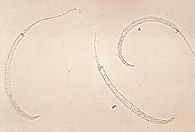
Dracunculiasis is also known as Guinea-worm disease. In 2019 53 cases were reported across 4 countries.,[46] a substantial decrease from 3,500,000 cases in 1986.[47] It is not fatal, but can cause months of inactivity.[48] It is caused by drinking water contaminated by water fleas infected with guinea-worm larvae.[48] Approximately one year after infection, a painful blister forms and one or more worms emerge. Worms can be up to 1 m long.[48] It is usually treated by World Health Organization volunteers who clean and bandage wounds caused by worms and return daily to pull the worm out a few more inches.[48] Dracunculiasis is preventable by water filtration, immediate case identification to prevent spread of disease, health education, and treating ponds with larvicide. An eradication program has been able to reduce prevalence.[48] As of 2014[update], the four endemic countries are Chad, Ethiopia, Mali, and South Sudan.[48]
Echinococcosis
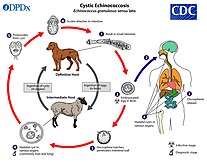
The rates of echinococcosis is higher in rural areas, and there are more than one million people infected currently.[49] Untreated alveolar echinococcosis is fatal.[50] It is caused by ingesting parasites in animal feces.[51] There are two versions of the disease: cystic and alveolar. Both versions involve an asymptomatic incubation period of several years. In the cystic version, liver cysts cause abdominal pain, nausea and vomiting while cysts in the lungs cause chronic cough, chest pain, and shortness of breath. In alveolar echinococcosis, a primary cyst develops, usually in the liver, in addition to weight loss, abdominal pain, general feeling of ill health, and signs of liver failure.[50]
Surgery and drugs can both be used to treat echinococcosis.[50] It can be prevented by deworming dogs, sanitation, proper disposal of animal feces, health education, and livestock vaccination.[52] Cystic echinococcosis is found in the eastern portion of the Mediterranean region, northern Africa, southern and eastern Europe, the southern portion of South America, and central Asia. Alveolar echinococcosis is found in western and northern China, Russia, Europe, and northern North America.[51] It can be diagnosed through imaging techniques and serological tests.[52]
Yaws
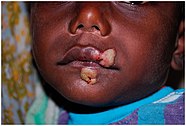
There are limited data available on the prevalence of yaws, although it primarily affects children.[53] The mortality risk is very low, but the disease causes disfigurement and disability if untreated.[53] The most common symptom is skin lesions.[53] It is a chronic bacterial infection, transmitted by skin contact, and caused by the spirochete bacterium Treponema pallidum pertenue.[53] It is treated with antibiotics and can be prevented through improved hygiene and sanitation.[53] Yaws is most prevalent in the warm, moist, tropical regions of the Americas, Africa, Asia, and the Pacific.[53]
Foodborne trematodiases
The foodborne trematode infections include clonorchiasis, opisthorchiasis, fascioliasis, and paragonimiasis. These infections are all zoonotic, primarily affecting domestic or wild animals, but also transmitted to humans. They are acquired by eating food, such as raw fish, contaminated with the larval stages of the parasites. At least 40 million people are thought to be infected.[54]
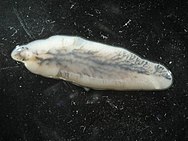
Human African trypanosomiasis
African trypanosomiasis (African sleeping sickness) is a somewhat rare disease as there are fewer than 10,000 cases currently.[55] Human African trypanosomiasis is vector-borne, and spread through the bite of the tsetse fly.[41] The most common symptoms are fever, headache, lymphadenopathy, nocturnal sleeping pattern, personality changes, cognitive decline, and coma. The disease is always fatal if untreated. The current forms of treatment are highly toxic and ineffective as resistance is spreading. It is diagnosed through an inexpensive serological test.[medical citation needed]
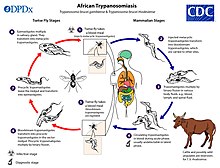
Leishmaniasis
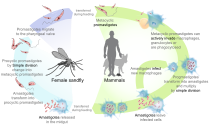
The three forms of leishmaniasis are visceral (Kala-azar), cutaneous, and mucocutaneous.[56] There are an estimated 12 million people infected.[21] It is fatal if untreated and 20,000 deaths from visceral leishmaniasis occur annually.[57] It is a vector-borne disease that is caused by the bite of sandflies.[41] At least 90 percent of visceral leishmaniasis occurs in Bangladesh, Brazil, Ethiopia, India, South Sudan, and Sudan. Cutaneous leishmaniasis occurs in Afghanistan, Algeria, Brazil, Colombia, Iran, Pakistan, Peru, Saudi Arabia, and Syria. Around 90 percent of mucocutaneous leishmaniasis occurs in Bolivia, Brazil, and Peru.[56]
The only method of prevention is a vaccine that is under development and prevention of sandfly bites. Diagnosis can be made by identifying clinical signs, serological tests, or parasitological tests.[58] Leishmaniasis can be treated with expensive medications.[59]
Leprosy
According to recent figures from the WHO, 208 619 new cases of leprosy were reported in 2018 from 127 countries.[60] It is most prevalent in India (69% of cases), Brazil, Indonesia, Nigeria, Democratic Republic of the Congo, Madagascar and East Africa, from Mozambique to Ethiopia, with the highest relative incidence in India, Brazil and Nepal.[61] There are one million to two million individuals currently disabled or disfigured due to past or present leprosy.[62] It is caused by bacteria and transmitted through droplets from the mouth and nose of infected individuals.[63] Leprosy causes disfigurement and physical disabilities if untreated. It is curable if treated early.[62] Treatment requires multidrug therapy.[61] The BCG vaccine has some preventative effect against leprosy. Leprosy has a 5–20 year incubation period, and the symptoms are damage to the skin, nerves, eyes, and limbs.[63]
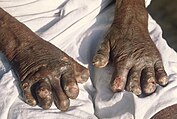
Lymphatic filariasis
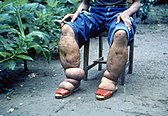
Lymphatic filariasis is also known as elephantiasis. There are approximately 120 million individuals infected[64] and 40 million with deformities.[19] Approximately two-thirds of cases are in Southwest Asia and one-third in Africa.[64] Lymphatic filariasis is rarely fatal.[65] Lymphatic filariasis has lifelong implications, such as lymphoedema of the limbs, genital disease, and painful recurrent attacks. Most people are asymptomatic, but have lymphatic damage. Up to 40 percent of infected individuals have kidney damage.[66] It is a vector-borne disease, caused by nematode worms that are transmitted by mosquitoes.[41][66]
It can be treated with cost-effective antihelminthic treatments,[67] and washing skin can slow or even reverse damage.[68] It is diagnosed with a finger-prick blood test.[65]
Onchocerciasis
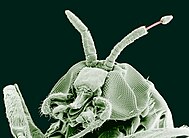
Onchocerciasis is also known as "river blindness". There are 20.9 million people infected[69] and prevalence is higher in rural areas.[70] Over 99 percent of cases are in Sub-Saharan Africa.[70] It causes blindness, skin rashes, lesions, intense itching, and skin depigmentation.[71] It is a vector-borne disease, caused by filarial worm infected blackflies.[41][71]
It can be treated with ivermectin.[71] It can be prevented by insecticide spraying or preventative dosing with ivermectin.[70] The symptoms are generally itching and skin lesions.[70]
Rabies
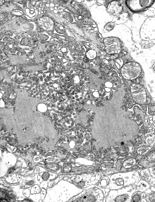
There are two forms of rabies: furious and paralytic. There are 60,000 deaths from rabies annually.[72] It is mostly found in Asia and Africa.[72] There is a higher prevalence in rural areas and it disproportionately affects children.[73] Rabies is fatal after symptoms develop.[74] It is caused by a lyssavirus transmitted through wounds or bites from infected animals.[73] The first symptoms are fever and pain near the infection site which occur after a one to three month incubation period. Furious (more common type) rabies causes hyperactivity, hydrophobia, aerophobia, and death by cardio-respiratory arrest occurs within days. Paralytic rabies causes a slow progression from paralysis to coma to death.[73]
It can be prevented in dogs by vaccination,[73] and cleaning and disinfecting bite wounds (post-exposure prophylaxis).[74] Rabies is undiagnosable before symptoms develop. It can be detected through tissue testing after symptoms develop.[73]
Schistosomiasis

There are over 200 million cases of schistosomiasis.[19] Approximately 85 percent of cases are in sub-Saharan Africa.[19] The disease can be fatal by causing bladder cancer and hematemesis.[19] Schistosoma species have a complex life cycle that alternates between humans and freshwater snails. Infection occurs when skin comes into contact with contaminated fresh water in which the snails that carry the parasite are living. Symptoms for schistosomiasis are not caused by the worms but by the body's reaction to the eggs. The eggs that do not pass out of the body can become lodged in the intestine or bladder, causing inflammation or scarring. Children who are repeatedly infected can develop anemia, malnutrition and learning difficulties.[75] The symptoms are usually haematuria, bladder obstruction, renal failure, bladder cancer, periportal fibrosis, bladder fibrosis, liver fibrosis, portal hypertension, cervical lesions, ascites, and esophageal varices.[21][19]
Inexpensive praziquantel can be used to treat individuals with schistosomiasis, but cannot prevent reinfection. The cost of prevention is US$0.32 per child per year.[19] Mass deworming treatment with praziquantel, better access to safe water, sanitation, health education can all be used to prevent schistosomiasis.[21] Vaccines are under development. It can be diagnosed through a serological test, but it often produces false negatives.[19]
Soil-transmitted helminthiasis

The three major worm species responsible for soil-transmitted helminthiasis are Ascaris (roundworms), Trichuris (whipworm), the hookworms Necator americanus and Ancylostoma duodenale, and Strongyloides stercoralis.[76] There are 1.5 billion people currently infected.[76] Soil-transmitted heminthiasis occurs in sub-Saharan Africa, the Americas, China, and east Asia.[76] The mortality risk is very low.[21] The most common symptoms are anemia, stunted growth, intestinal problems, lack of energy, and compromised physical and cognitive development.[21][76] Infected children often fall behind in schooling.[21] The severity of symptoms depends on the number of worms in the body.[76]
Parasitic worms are generally transmitted via exposure to infected human feces and soil that are spread in the environment, for example, due to open defecation.[76] The most common treatment is medicine.[76] It can be prevented through hygienically prepared food and clean water, improved sanitation, periodic deworming, and health education.[76] The World Health Organization recommends mass deworming without prior diagnosis.[76]
Taeniasis/cysticercosis
Cysticercosis is a tapeworm larvae infection, while taeniasis is infection with adult tapeworms.[77] Both are found in Asia, Africa and Latin America, particularly on farms in which pigs are exposed to human excrement.[78]
Cysticercosis is the most common preventable cause of epilepsy in the developing world.[78] Cysticercosis occurs after ingestion of contaminated food, water, or soil.[77] Cysts and lesions can cause headaches, blindness, seizures, hydrocephalus, meningitis, and dementia.[79] Neurocystocercosis, or the parasitic infection of the nervous system, can be fatal. Taeniasis is not fatal.[78][79] It is usually contracted after eating undercooked contaminated pork. Taeniasis has mild symptoms, including abdominal pain, nausea, diarrhea, or constipation.[citation needed]
Drugs are used to treat both diseases.[79] Infection can be prevented through stricter meat-inspection standards, livestock confinement, improved hygiene and sanitation, health education, safe meat preparation, and identifying and treating human and pig carriers.[80]
Trachoma
There are 21.4 million people infected with trachoma, of whom 2.2 million are partially blind and 1.2 million are blind. It is found in Africa, Asia, Central and South America, Middle East, and Australia.[81] The disease disproportionately affects women and children.[81] The mortality risk is very low, although multiple re-infections eventually lead to blindness.[21][81] The symptoms are internally scarred eyelids, followed by eyelids turning inward.[81] Trachoma is caused by a micro-organism that spreads through eye discharges (on hands, cloth, etc.) and by "eye-seeking flies".[81]
It is treated with antibiotics. The only known prevention method is interpersonal hygiene.[citation needed]
Chromoblastomycosis and other deep mycoses
Scabies
Snakebite envenoming
Snakebite was added to the list in 2017, after years of criticism of the WHO by activists for not making it a priority.[82] The greatest burden of snakebite morbidity is in India and Southeast Asia. Globally, there are an estimated 421,000 envenomings each year (about 1 in 4 snakebites) and 20,000 deaths, but snakebites often go unreported.[83]
Effects for patients
Social effects
Social stigma
Several NTDs, such as leprosy, cause severe deformities that result in social stigma. Stigma is considered to be the 'hidden burden' of neglected tropical diseases, and is not accounted for in measures such as disability-adjusted life years (DALYs). Other NTDs that carry heavy social stigma include onchocerciasis, lymphatic filariasis, plague, Buruli ulcer, leishmaniasis, and Chagas disease.[23] Lymphatic filariasis, for example, causes severe deformities that can result in denial of marriage and inability to work.[19] Studies in Ghana and Sri Lanka have demonstrated that support groups for patients with lymphatic filariasis can increase participants' self-esteem, quality of life, and social relations through social support and providing practical advice on how to manage their illness. The social effects of neglected tropical diseases have been shown to affect men and women in different ways. Men are socially stigmatized in a way that detrimentally affects their economic prospects. Women are more likely to be affected in the areas of marriage and family.[23]
Mental health
A 2012 review found that infection with a neglected tropical disease predisposes individuals to poor mental health. This is partially due to the social stigma that surround NTDs, but is also likely caused by the subsequent lack of access to health and social services. Overall, being a member of the infected community was found to cut individuals off from multiple aspects of society via civic rights, educational opportunities, and employment. The authors suggest that more research be directed into the psychological aspects of neglected tropical diseases in order to fully untangle their co-effects.[84]
Gender
NTDs disproportionately affect women and children.[85] There is also the added risk of hookworm infection during pregnancy and the potential to transfer diseases such as Chagas during pregnancy. A study in Uganda found that women were more easily able to obtain treatment because they had fewer occupational responsibilities than men and were more trusting of treatment, but ignorance of the effects of medicines on pregnant women prevented adequate care. The paper concludes that gender should be considered when designing treatment programs in Uganda.[86] Additionally, women often bear a heavier social stigma in relation to the pressure to marry.[19][dubious ][failed verification]
Economic effects
The cost of treatment of some of these diseases, such as Buruli ulcer, can amount to over twice the yearly income of an average household in the lowest income quartile, while for the highest income quartile, the burden is slightly less than the average household income. These enormous financial costs often cause deferral of treatment and financial ruin, but there is inequality between the wealthy and poor in terms of economic burden. These diseases also cost the government in terms of health care and lost worker productivity through morbidity and shortened life spans. In Kenya, for example, deworming is estimated to increase average adult income by 40 percent, which is a benefit-to-cost ratio of 100. Each untreated case of Trachoma is estimated to cost US$118 in lost productivity. Each case of schistosomiasis causes a loss of 45.4 days of work per year. Most of the diseases cost the economies of various developing countries millions of dollars. Large-scale prevention campaigns are predicted to increase agricultural output and education levels.[87]
The low cost of treatment for NTDs can be attributed to the large scale of the programs, free provision of drugs by pharmaceutical companies, delivery modes of drugs, and the unpaid volunteers who distribute the drugs. The economic burden of NTDs is undervalued and therefore the corresponding economic effect and cost-effectiveness of decreased prevalence of NTDs is underestimated.[87] The investment return on measures to control neglected tropical diseases is estimated to be between 14–30 percent, depending on the disease and region.[88]
Health effects
Coinfection
Coinfection is a major concern with neglected tropical diseases, making NTDs more damaging than their mortality rates might portray. Because the factors that support neglected tropical diseases (poverty, inadequate healthcare, inadequate sanitation practices, etc.) support all NTDs, they are often found in overlapping distributions. Helminth infections, as the most common infection of humans, are often found to be in multi-infection systems. For example, in Brazil, low socioeconomic status contributes to overcrowded housing. In these same areas, connection by Necator americanus and Schistosoma mansoni is common. The effect of each worm weakens the immune system of those infected, making infection from the other easier and more severe. For this reason, coinfection carries a higher risk of mortality. NTDs may also play a role in infection with other diseases, such as malaria, HIV/AIDS, and tuberculosis. The ability of helminths to manipulate the immune system may create a physiological environment that could exacerbate the progression of HIV/AIDS.[89] Some evidence from Senegal, Malawi, and Thailand has shown that helminth infections raise the risk of malarial infection.[90]
Prevention, treatment and eradication
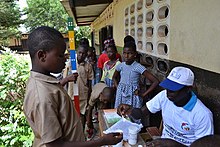
Prevention and eradication are important because "of the appalling stigma, disfigurement, blindness and disabilities caused by NTDs."[19] The possibility of eliminating or eradicating dracunculiasis, leprosy, lymphatic filariasis, onchocerciasis, trachoma, sleeping sickness, visceral leishmaniasis, and canine rabies within the next ten years was the principal aim of the London Declaration on Neglected Tropical Diseases, which is a collaborative effort involving the WHO, the World Bank, the Bill & Melinda Gates Foundation, the world's 13 leading pharmaceutical companies, and government representatives from US, UK, United Arab Emirates, Bangladesh, Brazil, Mozambique and Tanzania. It was launched in January 2012.[7]
While the current era has had a noticeable uptick in biological research into neglected tropical diseases, prevention may be supplemented by social and development outreach. Spiegal and his coauthors advocated for this to take the form of "social offset." Social offset entails the delegation of some of the funding for biotechnological research to social programs. The attempts to alleviate some of the surrounding factors (such as poverty, poor sanitation, overcrowding, poor healthcare etc.) that greatly exacerbate the conditions brought on by neglected tropical diseases. Projects such as these also strengthen the goal of sustained eliminations, rather than quickly addressing symptoms.[91]
Policy initiatives
There are many prevention and eradication campaigns funded for example by the World Health Organization, US Agency for International Development, Bill and Melinda Gates Foundation, UK Department for International Development.[19]
Sustainable Development Goal 3 has this target to eradicate NTDs: "By 2030, end the epidemics of AIDS, tuberculosis, malaria and neglected tropical diseases and combat hepatitis, water-borne diseases and other communicable diseases."[92]
WHO Roadmap of 2012
WHO published in 2012 the NTD "roadmap" which contains milestones for 2015 and 2020 and which specifies targets for eradication, elimination, and intensified control of the different NTDs.[93] For example:
- NTDs planned to be eradicated: dracunculiasis (by the year 2015), endemic treponematoses (yaws) (by 2020)
- NTDs planned to be eliminated globally by 2020: blinding trachoma, leprosy, human African trypanosomiasis, lymphatic filariasis
- NTDs planned to be eliminated in certain regions: rabies (by 2015 in Latin America, by 2020 in Southeast Asia and western Pacific regions), Chagas disease (transmission through blood transfusion by 2015, intra-domiciliary transmission by 2020 in the region of the Americas), visceral leishmaniasis (by 2020 in the Indian subcontinent), oncocerciasis (by 2015 in Latin America), schistosomiasis (by 2015 in eastern Mediterranean region, Caribbean, Indonesia and the Mekong River basin, by 2020 in the region of the Americas and western Pacific region)
- NTDs planned to be eliminated in certain countries: human African trypanosomiasis (by 2015 in 80 percent of areas in which it occurs), oncocerciasis (by 2015 in Yemen, by 2020 in selected countries in Africa), schistosomiasis (by 2020 in selected countries in Africa)
- Intensified control with specific targets for the years 2015 and 2020 are provided for these NTDs: dengue, buruli ulcer, cutaneous leishmaniasis, taeniasis/cysticercosis and echinococcosis/hydatidosis, foodborne trematode infections, soil-transmitted helmintheases
Others
The U.S. Food and Drug Administration priority review voucher is an incentive for companies to invest in new drugs and vaccines for tropical diseases. A provision of the Food and Drug Administration Amendments Act (HR 3580) awards a transferable "priority review voucher" to any company that obtains approval for a treatment for one of the listed diseases. The voucher can later be used to accelerate review of an unrelated drug. This program is for all tropical diseases and includes medicines for malaria and tuberculosis. The first voucher given was for Coartem, a malaria treatment.[94] It does not use or define the term "neglected" though most of the diseases listed are often included on lists of neglected diseases.[citation needed]
The prize was proposed by Duke University faculty Henry Grabowski, Jeffrey Moe, and David Ridley in their 2006 Health Affairs paper: "Developing Drugs for Developing Countries."[95] In 2007 United States Senators Sam Brownback (R-KS) and Sherrod Brown (D-OH) sponsored an amendment to the Food and Drug Administration Amendments Act of 2007. President George W. Bush signed the bill in September 2007.[citation needed]
Deworming treatment
Deworming treatments in infected children may have some nutritional benefit, as worms are often partially responsible for malnutrition.[19][96] However, in areas where these infections are common, there is strong evidence that mass deworming campaigns do not have a positive effect on children's average nutritional status, levels of blood haemoglobin, cognitive abilities, performance at school or survival.[96] To achieve health gains in the longer term, improvements in sanitation and hygiene behaviours are also required, together with deworming treatments.[citation needed]
The effects of mass deworming on school attendance is controversial. It has been argued that mass deworming has a positive effect on school attendance.[19] The long-term benefits of deworming include a decrease in school absenteeism by 25 percent, and an increase in adult earnings by 20 percent.[97] A systematic review, however, found that there is little or no difference in attendance in children who receive mass deworming compared to children who did not.[98] One study found that boys were enrolled in primary school for more years than boys who were in schools that did not offer such programs. Girls in the same study were about a quarter more likely to attend secondary school if they received treatment. Both groups went on to participate in more skilled sectors of the labor market. The economic growth generated from school programs such as this may balance out the actual expenses of the program.[99] But the results of this study are disputed (i.a. due to a high risk of bias in the study) and the positive long-term outcomes of mass deworming remain unclear.[98]
Integration of treatment

Inclusion of NTDs into initiatives for malaria, HIV/AIDS, and tuberculosis, as well as integration of NTD treatment programs, may have advantages given the strong link between these diseases and NTDs.[7][90][100] Some neglected tropical diseases share common vectors (sandflies, black flies, and mosquitos).[90] Both medicinal and vector control efforts may be combined.[101]
A four-drug rapid-impact package has been proposed for widespread proliferation. Administration may be made more efficient by targeting multiple diseases at once, rather than separating treatment and adding work to community workers. This package is estimated to cost US$0.40 per patient. When compared to stand-alone treatment, the savings are estimated to be 26–47%. While more research must be done in order to understand how NTDs and other diseases interact in both the vector and the human stages, safety assessments have so far produced positive results.[90]
Many neglected tropical diseases and other prevalent diseases share common vectors, creating another opportunity for treatment and control integration. One such example of this is malaria and lymphatic filariasis. Both diseases are transmitted by the same or related mosquito vectors. Vector control, through the distribution of insecticide treated nets, reduces the human contact with a wide variety of disease vectors. Integrated vector control may also alleviate pressure on mass drug administration, especially with respect to rapidly evolving drug resistance. Combining vector control and mass drug administration deemphasizes both, making each less susceptible to resistance evolution.[101]
Integration with WASH programs
Water, sanitation, and hygiene (WASH) interventions are essential in preventing many NTDs, for example soil-transmitted helminthiasis.[102] Mass drug administrations alone will not protect people from re-infection. A more holistic and integrated approach to NTDs and WASH efforts will benefit both sectors along with the communities they are aiming to serve. This is especially true in areas that are endemic with more than one NTD.[102]
In August 2015 the World Health Organization unveiled a global strategy and action plan to integrate WASH with other public health interventions in order to accelerate elimination of NTDs.[103] The plan aims to intensify control or eliminate certain NTDs in specific regions by 2020 and refers to the NTD "roadmap" milestones from 2012 that include for example eradication of dracunculiasis by 2015 and of yaws by 2020, elimination of trachoma and lymphatic filariasis as public health problems by 2020, intensified control of dengue, schistosomiasis and soil-transmitted helminthiases.[31]
A closer collaboration between WASH and NTD programmes can lead to synergies. They can be achieved through collaborative planning, delivery and evaluation of programmes, strengthening and sharing of evidence, and using monitoring tools to improve the equity of health services.[104]
Reasons why WASH plays an important role in NTD prevention and patient care include:[31]
- NTDs affect more than one billion people in 149 countries. They occur mainly in regions with a lack of basic sanitation. About 2.4 billion people worldwide do not have adequate sanitation facilities. 663 million do not have access to improved drinking water sources.[105]
- One leading cause of preventable blindness is trachoma. The bacterial infection is transmitted through contact with eye-seeking flies, fingers, and fomites. Prevention components are facial cleanliness, which requires water for face washing, and environmental improvement, which includes safe disposal of excreta to reduce fly populations.[106]
- Improved sanitation prevents soil-transmitted helminthiases. It impedes fecal pathogens such as intestinal worm eggs from contaminating the environment and infecting people through contaminated food, water, dirty hands, and direct skin contact with the soil.[107]
- Improved sanitation and water management can contribute to reduce proliferation of mosquitoes that transmit diseases, such as lymphatic filariasis, dengue and chikungunya. Breeding of the Culex mosquito which transmits filarial parasites is facilitated through poorly constructed latrines. Breeding of the Aedes aegypti and Aedes albopictus mosquitoes which transmit dengue and chikungunya can be prevented through safe storage of water.[108]
- Feces and urine that contain worm eggs can contaminate surface water and lead to transmission of schistosomiasis. This can be prevented through improved sanitation. Not only human but also animal (cow, buffalo) urine or feces can transmit some schistosome species. Therefore, it is important to protect freshwater from animals and animal waste.[109]
- Treatment of many NTDs require clean water and hygienic conditions for healthcare facilities and households. For guinea worm, Buruli ulcer, or cutaneous leishmaniasis, wound management is needed to speed up healing and reduce disability. Lymphatic filariasis causes chronic disabilities. People who suffer from this disease need to maintain rigorous personal hygiene with water and soap to prevent secondary infections.[110]
- NTDs that lead to permanent disabilities make tasks such as carrying water long distances or accessing toilets difficult. However, people affected by these diseases often face stigma and can be excluded from accessing water and sanitation facilities. This increases their risk of poverty and severe illness. Clean water and soap are essential for these groups to maintain personal hygiene and dignity. Therefore, additional efforts to reduce stigma and exclusion are needed. In this manner, WASH can improve quality of life of people affected by NTDs.[111]
- In a meta-analysis safe water was associated with significantly reduced odds of Schistosoma infection, and adequate sanitation was associated with significantly lower odds of infection with both S. mansoni and S. haematobium.[112]
- A systematic review and meta-analysis showed that better hygiene in children is associated with lower odds of trachoma. Access to sanitation was associated with 15 percent lower odds of active trachoma and 33 percent lower odds of C. trachomatis infection of the eyes.[113]
- Another systematic review and meta-analysis found a correlation between WASH access and practices and lower odds of soil-transmitted helminthiasis infections by 33 to 77 percent. Persons who washed their hands after defecating were less than half as likely to be infected as those who did not.[114] Traditionally, preventive chemotherapy is used as a measure of control, although this measure does not stop the transmission cycle and cannot prevent reinfection. In contrast, improved sanitation can.[115]
Pharmaceutical market
Biotechnology companies in the developing world have targeted neglected tropical diseases due to need to improve global health.[116]
Mass drug administration is considered a possible method for eradication, especially for lymphatic filariasis, onchocerciasis, and trachoma, although drug resistance is a potential problem.[117] According to Fenwick, Pfizer donated 70 million doses of drugs in 2011 to eliminate trachoma through the International Trachoma Initiative.[19] Merck has helped The African Programme for the Control of Onchocerciasis (APOC) and Oncho Elimination Programme for the Americas to greatly diminished the effect of onchocerciasis by donating ivermectin.[19] Merck KGaA pledged to give 200 million tablets of praziquantel over 10 years, the only cure for schistosomiasis.[118] GlaxoSmithKline has donated two billion tablets of medicine for lymphatic filariasis and pledged 400 million deworming tablets per year for five years in 2010. Johnson & Johnson has pledged 200 million deworming tablets per year.[19] Novartis has pledged leprosy treatment, EISAI pledged two billion tablets to help treat lymphatic filariasis.[19]
NGO initiatives
Non-governmental organizations that focus exclusively on NTDs include the Schistosomiasis Control Initiative, Deworm the World, and the END Fund.[119] Despite under-funding, many neglected diseases are cost-effective to treat and prevent. The cost of treating a child for infection of soil transmitted helminths and schistosomes (some of the main causes of neglected diseases), is less than US$0.50 per year, when administered as part of school-based mass deworming by Deworm the World. This programme is recommended by Giving What We Can and the Copenhagen Consensus Centre as one of the most efficient and cost-effective solutions. The efforts of Schistosomiasis Control Initiative to combat neglected diseases include the use of rapid-impact packages: supplying schools with packages including four or five drugs, and training teachers in how to administer them.[citation needed]
Health Action International based in Amsterdam worked with the WHO to get snakebite envenoming on the list of neglected tropical diseases.[82]
Public-private initiatives
An alternative model to the profit-driven drug development emerged in the years 2000 to provide an answer to the needs of these neglected patients. Product development partnerships (PDPs) aim at implementing and accelerating the research and development (R&D) of safe and effective health tools (diagnostics, vaccines, drugs) to notably combat diseases that are neglected.[120] Drugs for Neglected Disease initiative (DNDi) is one of these PDPs that has already developed new treatments for NTDs[121]
The Sabin Vaccine Institute, founded in 1993, works to address the issues of vaccine-preventable diseases as well as NTDs. They run three main programs, Sabin Vaccine Development, Global Network for Neglected Tropical Diseases, and Vaccine Advocacy and Education.[122] Their product development partnership affiliates them with the Texas Children's Hospital as well as the Baylor College of Medicine. Their major campaign, End7, aims to end seven of the most common NTDs (elephantiasis, river blindness, snail fever, trachoma, roundworm, whipworm and hookworm) by 2020. Through End7, college campuses undertake fundraising and educational initiatives for the broader goals of the campaign.[123]
WIPO Re:Search was established in 2011 by the World Intellectual Property Organization in collaboration with BIO Ventures for Global Health (BVGH) and with the active participation of leading pharmaceutical companies and other private and public sector research organizations. It allows organizations to share their intellectual property, compounds, expertise, facilities and know-how royalty-free with qualified researchers worldwide working on new solutions for NTDs, malaria and tuberculosis.[124][125]
In 2013, the Government of Japan, five Japanese pharmaceutical companies, the Bill and Melinda Gates Foundation, and the UNDP established a new public-private partnership, Global Health Innovative Technology Fund. They pledged over US$100 million to the fund over five years, to be awarded as grants to R&D partnerships across sectors in Japan and elsewhere, working to develop new drugs and vaccines for 17 neglected diseases, in addition to HIV, malaria and tuberculosis.[126][127][128] Affordability of the resulting drugs and vaccines is one of the key criteria for grant awards.[126]
Others
An open-access journal dedicated to neglected tropical diseases called PLoS Neglected Tropical Diseases first began publication in 2007.
One of the first large-scale initiatives to address NTDs came from a collaboration between Kenneth Warren and the Rockefeller Foundation. Ken Warren is regarded as one of the founding figures in neglected tropical disease research. The Great Neglected Tropical Diseases Network was a consortium of scientists from all over the world, hand picked by Ken Warren, working to expand the research base in neglected diseases. Many of the scientists that he recruited had not been involved in NTD research before. The network ran from 1978 to 1988. Warren's vision was to establish units within biological labs across the world, dedicated to R&D. By forming a critical mass of scientists in NTD research, he hoped to attract new students into the field. The interdisciplinary group met annually to update the community on research progress. Much of the work done by this group focused on the understanding of the mechanisms behind infection. At these informally structured meetings, research partnerships were formed. Warren himself encouraged these partnerships, especially if they bridged the divide between developed and developing nations. Through the Great Neglected Tropical Disease Network, a great number of scientists were brought into the field of parasitology.[129]
Epidemiology

The distribution of neglected tropical disease disproportionally affects about one billion of the world's poorest populations[130] causing mortality, disability, and morbidity.[131] Lack of funding, resources, and attention can result in treatable and preventable diseases causing death.[132] Factors like political dynamics, poverty, and geographical conditions can make the delivery of NTD control programs difficult.[130] Intersectional collaboration of poverty reduction policies and neglected tropical diseases creates cross-sector approaches to simultaneously address these issues.[130]
The six most common NTDs include soil-transmitted helminths (STHs)—specifically roundworm (Ascaris lumbricoides), whipworm (Trichuris trichiura) and hookworms (Necator americanus and Ancylostoma duodenale)—schistosomiasis, trachoma, and lymphatic filariasis (LF).[102] These diseases affect one-sixth of the world's population with 90 percent of the disease burden occurring in sub-Saharan Africa.[102]
Information on the frequency of neglected tropical diseases is of low quality. It is currently difficult to summarize all of the information on this family of diseases. One effort to do so is the Global Burden of Disease framework. It aims to create a standardized method of measurement. The principle components of the approach involve 1) the measuring of premature mortality as well as disability, 2) the standardized usage of DALYs (disability-adjusted life years), and 3) wide spread inclusion of diseases and injury causes with the estimation of missing data.[133] However, the DALY has been criticized as a 'systematic undervaluation' of disease burden. King [134] asserts that the DALY emphasizes the individual too much, while ignoring the effects of the ecology of the disease. In order for the measure to become more valid, it may have to take the context of poverty more into account. King also emphasizes that DALYs may not capture the non-linear effects of poverty on cost-utility analysis of disease control. The Socio-Demographic Index (SDI) and Healthy Life Expectancy (HALE) are other summary measures that can be used to take into account other factors.[135] HALE is a metric that weights years lived and health loss before death to provides a summary of population health.[136] SDI is a measurement that includes lag-distributed income per capita, average education, and fertility rate.[131] Socioeconomic factors greatly influence the distribution of neglected tropical diseases, and not addressing these factors in models and measurements can lead to ineffective public health policy.[132]
History
In 1977 Kenneth S Warren, an American researcher, invented the concept of what is now "neglected tropical diseases".[137] The term was coined by Peter Hotez and colleagues in 2003.[1]
See also
- Contagious disease
- Fecal-oral transmission
- Neglected Tropical Disease Research and Development
- Drugs for Neglected Diseases Initiative
- Eradication of infectious diseases
- Global Network for Neglected Tropical Diseases
- Orphan diseases
References
- ↑ 1.0 1.1 1.2 1.3 1.4 1.5 Winkler, Andrea Sylvia; Klohe, Katherina; Schmidt, Veronika; Haavardsson, Ingleborg; Abraham, Annette; Prodjinotho, Ulrich Fabien; Ngowi, Bernard; Sikasunge, Chummy; Noormahomed, Emilia; Amausi, John; Kadacu, Joyce; Ngowi, Helena; Abele-Ridder, Bernadette; Harrison, Wendy Elizabeth; Prazeres Da Costa, Clarissa (6 February 2018). "Neglected tropical diseases – the present and the future". Tidsskrift for den Norske laegeforening : tidsskrift for praktisk medicin, ny raekke. 138 (3). doi:10.4045/tidsskr.17.0678. ISSN 0029-2001. PMID 29411594. Archived from the original on 30 August 2021. Retrieved 30 August 2021.
- ↑ Yotsu, Rie R. (14 November 2018). "Integrated Management of Skin NTDs—Lessons Learned from Existing Practice and Field Research". Tropical Medicine and Infectious Disease. 3 (4). doi:10.3390/tropicalmed3040120. ISSN 2414-6366. PMID 30441754. Archived from the original on 30 August 2021. Retrieved 30 August 2021.
- ↑ 3.0 3.1 3.2 3.3 3.4 "Neglected tropical diseases -- Global (Overview)". www.who.int. Archived from the original on 30 August 2021. Retrieved 30 August 2021.
- ↑ 4.0 4.1 "Neglected tropical diseases -- Global (Impact)". www.who.int. Archived from the original on 30 August 2021. Retrieved 30 August 2021.
- ↑ 5.0 5.1 5.2 5.3 5.4 Hotez PJ, Aksoy S, Brindley PJ, Kamhawi S (January 2020). "What constitutes a neglected tropical disease?". PLOS Neglected Tropical Diseases. 14 (1): e0008001. doi:10.1371/journal.pntd.0008001. PMC 6991948. PMID 31999732.
- ↑ "Neglected tropical diseases -- Global". www.who.int. Archived from the original on 30 August 2021. Retrieved 30 August 2021.
- ↑ 7.0 7.1 7.2 Hotez PJ (November 2013). "NTDs V.2.0: "blue marble health"--neglected tropical disease control and elimination in a shifting health policy landscape". PLOS Neglected Tropical Diseases. 7 (11): e2570. doi:10.1371/journal.pntd.0002570. PMC 3836998. PMID 24278496.

- ↑ Hotez PJ, Kamath A (August 2009). Cappello M (ed.). "Neglected tropical diseases in sub-saharan Africa: review of their prevalence, distribution, and disease burden". PLOS Neglected Tropical Diseases. 3 (8): e412. doi:10.1371/journal.pntd.0000412. PMC 2727001. PMID 19707588.

- ↑ Formiga, Fabio Rocha; Inamuddin; Severino, Patricia (2021). Applications of Nanobiotechnology for Neglected Tropical Diseases. London: Academic Press. pp. xxix. ISBN 978-0-12-821100-7. Archived from the original on 2021-08-30. Retrieved 2021-08-30.
- ↑ "Research Publications | Poverty Solutions at The University of Michigan". www.npc.umich.edu. Archived from the original on 23 July 2017. Retrieved 16 January 2018.
- ↑ Hotez PJ (September 2012). "Fighting neglected tropical diseases in the southern United States" (PDF). BMJ. 345: e6112. doi:10.1136/bmj.e6112. PMID 22977143. S2CID 22530671. Archived (PDF) from the original on 10 May 2017.
- ↑ "Making the Case to Fight Schistosomiasis". National Public Radio. Archived from the original on 10 October 2008. Retrieved 1 December 2008.
- ↑ Hotez PJ (January 2010). "A plan to defeat neglected tropical diseases". Scientific American. 302 (1): 90–4, 96. Bibcode:2010SciAm.302a..90H. doi:10.1038/scientificamerican0110-90. PMID 20063641. Archived from the original on 6 August 2014.
- ↑ Reddy M, Gill SS, Kalkar SR, Wu W, Anderson PJ, Rochon PA (October 2007). "Oral drug therapy for multiple neglected tropical diseases: a systematic review". JAMA. 298 (16): 1911–24. doi:10.1001/jama.298.16.1911. PMID 17954542.
- ↑ 15.0 15.1 15.2 15.3 Hotez P (1 November 2009). "Neglected diseases amid wealth in the United States and Europe". Health Affairs. 28 (6): 1720–5. doi:10.1377/hlthaff.28.6.1720. PMID 19887412.
- ↑ "DNDi – Best Science for the Most Neglected". www.dndi.org. Archived from the original on 13 March 2018. Retrieved 5 May 2018.
- ↑ 17.0 17.1 "World Health Organization". World Health Organization. Archived from the original on 20 October 2017. Retrieved 5 May 2018.
- ↑ "World Health Organization". World Health Organization. Archived from the original on 22 February 2014. Retrieved 18 June 2017.
- ↑ 19.00 19.01 19.02 19.03 19.04 19.05 19.06 19.07 19.08 19.09 19.10 19.11 19.12 19.13 19.14 19.15 19.16 19.17 19.18 Fenwick A (March 2012). "The global burden of neglected tropical diseases". Public Health. 126 (3): 233–236. doi:10.1016/j.puhe.2011.11.015. PMID 22325616.
- ↑ 20.0 20.1 Hotez P, Ottesen E, Fenwick A, Molyneux D (2006-01-01). "The neglected tropical diseases: the ancient afflictions of stigma and poverty and the prospects for their control and elimination". Advances in Experimental Medicine and Biology. 582: 23–33. doi:10.1007/0-387-33026-7_3. ISBN 978-0-387-31783-0. PMID 16802616.
- ↑ 21.00 21.01 21.02 21.03 21.04 21.05 21.06 21.07 21.08 21.09 21.10 21.11 21.12 Feasey N, Wansbrough-Jones M, Mabey DC, Solomon AW (2010). "Neglected tropical diseases". British Medical Bulletin. 93 (1): 179–200. doi:10.1093/bmb/ldp046. PMID 20007668.
- ↑ Payne L, Fitchett JR (September 2010). "Bringing neglected tropical diseases into the spotlight". Trends in Parasitology. 26 (9): 421–3. doi:10.1016/j.pt.2010.06.002. PMID 20591739.
- ↑ 23.0 23.1 23.2 23.3 Weiss MG (May 2008). "Stigma and the social burden of neglected tropical diseases". PLOS Neglected Tropical Diseases. 2 (5): e237. doi:10.1371/journal.pntd.0000237. PMC 2359851. PMID 18478049.

- ↑ Weiss MG (May 2008). "Stigma and the social burden of neglected tropical diseases". PLOS Neglected Tropical Diseases. 2 (5): e237. doi:10.1371/journal.pntd.0000237. PMC 2359851. PMID 18478049.
- ↑ "Subscribe to read". Financial Times. 28 October 2014. Archived from the original on 30 August 2021. Retrieved 5 May 2018.
- ↑ 26.0 26.1 Trouiller P, Olliaro P, Torreele E, Orbinski J, Laing R, Ford N (June 2002). "Drug development for neglected diseases: a deficient market and a public-health policy failure". Lancet. 359 (9324): 2188–94. doi:10.1016/S0140-6736(02)09096-7. hdl:10144/28441. PMID 12090998. S2CID 1616485.
- ↑ Colatrella B (September 2008). "The Mectizan Donation Program: 20 years of successful collaboration - a retrospective". Annals of Tropical Medicine and Parasitology. 102 Suppl 1: 7–11. doi:10.1179/136485908X337418. PMID 18718147. S2CID 32987420.
- ↑ Gillis J (25 April 2006). "Cure for Neglected Diseases: Funding". Washington Post. Archived from the original on 12 January 2020. Retrieved 26 August 2021.
- ↑ Disease control priorities in developing countries (2nd ed.). Oxford University Press. 2006. ISBN 978-0-821-36179-5.
- ↑ 30.0 30.1 Hotez PJ (September 2014). "Neglected parasitic infections and poverty in the United States". PLOS Neglected Tropical Diseases. 8 (9): e3012. doi:10.1371/journal.pntd.0003012. PMC 4154650. PMID 25188455.
- ↑ 31.0 31.1 31.2 World Health Organization (WHO) (2015): Water Sanitation and Hygiene for accelerating and sustaining progress on Neglected Tropical Diseases. A global strategy 2015 – 2020 Archived 25 September 2015 at the Wayback Machine. Geneva, Switzerland, p. 26
- ↑ Kirchhoff LV (August 1993). "American trypanosomiasis (Chagas' disease)--a tropical disease now in the United States". The New England Journal of Medicine. 329 (9): 639–44. doi:10.1056/NEJM199308263290909. PMID 8341339.
- ↑ "Neglected tropical diseases". World Health Organization. Archived from the original on 22 February 2014. Retrieved 24 November 2015.
- ↑ "World Health Organization". World Health Organization. Archived from the original on 22 February 2014. Retrieved 30 October 2016.
- ↑ "CDC – Neglected Tropical Diseases – Diseases". www.cdc.gov. Archived from the original on 4 December 2014. Retrieved 30 October 2016.
- ↑ "PLoS Neglected Tropical Diseases: A Peer-Reviewed Open-Access Journal". journals.plos.org. Archived from the original on 14 November 2020. Retrieved 19 November 2020.
- ↑ 37.0 37.1 "Buruli Ulcer". World Health Organization. Archived from the original on 11 May 2016. Retrieved 2 May 2016.
- ↑ 38.0 38.1 "Buruli Ulcer". Archived from the original on 13 April 2014. Retrieved 12 March 2014.
- ↑ "Buruli Ulcer Endemic Countries". Archived from the original on 12 March 2014. Retrieved 12 March 2014.
- ↑ 40.0 40.1 40.2 40.3 40.4 40.5 40.6 "Chagas disease (American trypanosomiasis)". Archived from the original on 13 March 2014. Retrieved 12 March 2014.
- ↑ 41.0 41.1 41.2 41.3 41.4 "World Health Day 2014: small bite, big threat". Archived from the original on 27 February 2014. Retrieved 12 March 2014.
- ↑ 42.0 42.1 42.2 42.3 42.4 42.5 "Dengue Control". Archived from the original on 12 March 2014. Retrieved 12 March 2014.
- ↑ 43.0 43.1 43.2 Pialoux G, Gaüzère BA, Jauréguiberry S, Strobel M (May 2007). "Chikungunya, an epidemic arbovirosis". The Lancet. Infectious Diseases. 7 (5): 319–27. doi:10.1016/S1473-3099(07)70107-X. PMID 17448935.
- ↑ "Symptoms, Diagnosis, & Treatment | Chikungunya virus | CDC". www.cdc.gov. 2018-12-17. Archived from the original on 2016-09-21. Retrieved 2020-03-17.
- ↑ Chikungunya, WHO, archived from the original on 20 January 2016, retrieved 21 January 2016
- ↑ "View Latest Worldwide Guinea Worm Case Totals". www.cartercenter.org. Archived from the original on 19 December 2018. Retrieved 28 February 2020.
- ↑ "Dracunculiasis eradication - global surveillance summary, 2009" (PDF). Relevé Épidémiologique Hebdomadaire. 85 (19): 166–76. May 2010. PMID 20449943. Archived (PDF) from the original on 3 March 2016.
- ↑ 48.0 48.1 48.2 48.3 48.4 48.5 "Dracunculiasis". Archived from the original on 5 April 2014. Retrieved 13 March 2014.
- ↑ "Echinococcosis". Archived from the original on 16 March 2014. Retrieved 16 March 2014.
- ↑ 50.0 50.1 50.2 "Signs, symptoms and treatment of echinococcosis". Archived from the original on 24 May 2015. Retrieved 16 March 2014.
- ↑ 51.0 51.1 "Transmission of echinococcosis". Archived from the original on 5 June 2015. Retrieved 16 March 2014.
- ↑ 52.0 52.1 "Surveillance, prevention and control of echinococcosis". Archived from the original on 16 March 2014. Retrieved 16 March 2014.
- ↑ 53.0 53.1 53.2 53.3 53.4 53.5 "Yaws". Archived from the original on 15 March 2014. Retrieved 16 March 2014.
- ↑ "Foodborne trematode infections". World Health Organization. Archived from the original on 25 November 2015. Retrieved 24 November 2015.
- ↑ "Human African Trypanosomiasis: number of new cases falls to historical low in 50 years". Archived from the original on 25 October 2013.
- ↑ 56.0 56.1 "Burden and Distribution". Archived from the original on 16 March 2014. Retrieved 16 March 2014.
- ↑ "Leishmaniasis". Archived from the original on 15 March 2014. Retrieved 16 March 2014.
- ↑ "Diagnosis, detection and surveillance". Archived from the original on 16 March 2014. Retrieved 16 March 2014.
- ↑ "Access to essential antileishmanial medicines and treatment". Archived from the original on 16 March 2014. Retrieved 16 March 2014.
- ↑ "Leprosy: New data show steady decline in new cases". WHO. 9 September 2019. Archived from the original on 3 May 2020. Retrieved 26 August 2021.
- ↑ 61.0 61.1 "Leprosy Today". Archived from the original on 14 March 2014. Retrieved 16 March 2014.
- ↑ 62.0 62.1 "Leprosy: the disease". Archived from the original on 16 March 2014. Retrieved 16 March 2014.
- ↑ 63.0 63.1 "Leprosy". 10 September 2019. Archived from the original on 31 January 2021.
- ↑ 64.0 64.1 "Epidemiology". Archived from the original on 16 March 2014. Retrieved 16 March 2014.
- ↑ 65.0 65.1 "Forms of Lymphatic Filariasis and diagnosis". Archived from the original on 16 March 2014. Retrieved 16 March 2014.
- ↑ 66.0 66.1 "Lymphatic filariasis". Archived from the original on 30 March 2014. Retrieved 16 March 2014.
- ↑ Mohammed KA, Haji HJ, Gabrielli AF, Mubila L, Biswas G, Chitsulo L, et al. (January 2008). Utzinger J (ed.). "Triple co-administration of ivermectin, albendazole and praziquantel in zanzibar: a safety study". PLOS Neglected Tropical Diseases. 2 (1): e171. doi:10.1371/journal.pntd.0000171. PMC 2217668. PMID 18235853.

- ↑ "Clinical manifestations". Archived from the original on 16 March 2014. Retrieved 16 March 2014.
- ↑ "Onchocerciasis". World Health Organization. 14 June 2019. Archived from the original on 11 April 2020. Retrieved 26 August 2021.
- ↑ 70.0 70.1 70.2 70.3 "Onchocerciasis". Archived from the original on 16 March 2014. Retrieved 16 March 2014.
- ↑ 71.0 71.1 71.2 "Onchocerciasis". Archived from the original on 9 April 2014. Retrieved 16 March 2014.
- ↑ 72.0 72.1 "Rabies". Archived from the original on 24 February 2014. Retrieved 16 March 2014.
- ↑ 73.0 73.1 73.2 73.3 73.4 "About rabies". Archived from the original on 30 January 2014. Retrieved 16 March 2014.
- ↑ 74.0 74.1 "Rabies". Archived from the original on 1 April 2014. Retrieved 16 March 2014.
- ↑ "Schistosomiasis-Disease". CDC, Division of Parasitic Diseases. Archived from the original on 2 December 2016. Retrieved 17 October 2016.
- ↑ 76.0 76.1 76.2 76.3 76.4 76.5 76.6 76.7 76.8 "Soil-transmitted helminth infections". Archived from the original on 21 February 2014. Retrieved 16 March 2014.
- ↑ 77.0 77.1 "Transmission of taeniasis/cysticercosis". Archived from the original on 14 March 2014. Retrieved 13 March 2014.
- ↑ 78.0 78.1 78.2 "About Taeniasis/cysticercosis". Archived from the original on 14 March 2014. Retrieved 13 March 2014.
- ↑ 79.0 79.1 79.2 "Signs, symptoms and treatment of taeniasis/cysticercosis". Archived from the original on 14 March 2014. Retrieved 13 March 2014.
- ↑ "Surveillance, prevention and control of taeniasis/cysticercosis". Archived from the original on 14 March 2014. Retrieved 13 March 2014.
- ↑ 81.0 81.1 81.2 81.3 81.4 "Priority eye diseases". Archived from the original on 26 July 2014. Retrieved 16 March 2014.
- ↑ 82.0 82.1 "Snakebite finally makes a WHO list of top global health priorities". STAT. 12 June 2017. Archived from the original on 13 June 2017. Retrieved 18 June 2017.
- ↑ Kasturiratne A, Wickremasinghe AR, de Silva N, Gunawardena NK, Pathmeswaran A, Premaratna R, et al. (November 2008). "The global burden of snakebite: a literature analysis and modelling based on regional estimates of envenoming and deaths". PLOS Medicine. 5 (11): e218. doi:10.1371/journal.pmed.0050218. PMC 2577696. PMID 18986210.
- ↑ Litt E, Baker MC, Molyneux D (May 2012). "Neglected tropical diseases and mental health: a perspective on comorbidity". Trends in Parasitology. 28 (5): 195–201. doi:10.1016/j.pt.2012.03.001. PMID 22475459.
- ↑ Kealey A, Smith? R (February 2010). "Neglected tropical diseases: infection, modeling, and control". Journal of Health Care for the Poor and Underserved. 21 (1): 53–69. doi:10.1353/hpu.0.0270. PMID 20173255. S2CID 27293058.
- ↑ Rilkoff H, Tukahebwa EM, Fleming FM, Leslie J, Cole DC (2013). "Exploring gender dimensions of treatment programmes for neglected tropical diseases in Uganda". PLOS Neglected Tropical Diseases. 7 (7): e2312. doi:10.1371/journal.pntd.0002312. PMC 3708858. PMID 23875047.

- ↑ 87.0 87.1 Conteh L, Engels T, Molyneux DH (January 2010). "Socioeconomic aspects of neglected tropical diseases". Lancet. 375 (9710): 239–47. doi:10.1016/S0140-6736(09)61422-7. PMID 20109925. S2CID 20630557.
- ↑ Molyneux DH (2004). ""Neglected" diseases but unrecognised successes--challenges and opportunities for infectious disease control". Lancet. 364 (9431): 380–3. doi:10.1016/S0140-6736(04)16728-7. PMID 15276399. S2CID 42273787.
- ↑ Lindoso JA, Lima AC, Cunha MA, Gomes CM (23 August 2015). "Diagnosing Neglected Tropical Diseases in HIV Coinfection". Human Parasitic Diseases. 2015 (7): 11–18. doi:10.4137/HPD.S19569. Archived from the original on 17 November 2016.
- ↑ 90.0 90.1 90.2 90.3 Singer M, Bulled N (November 2012). "Interlocked Infections: The Health Burdens of Syndemics of Neglected Tropical Diseases". Annals of Anthropological Practice. 36 (2): 328–345. doi:10.1111/napa.12007.
- ↑ Spiegel JM, Dharamsi S, Wasan KM, Yassi A, Singer B, Hotez PJ, et al. (May 2010). "Which new approaches to tackling neglected tropical diseases show promise?". PLOS Medicine. 7 (5): e1000255. doi:10.1371/journal.pmed.1000255. PMC 2872649. PMID 20502599.
- ↑ United Nations (2017) Resolution adopted by the General Assembly on 6 July 2017, Work of the Statistical Commission pertaining to the 2030 Agenda for Sustainable Development (A/RES/71/313 Archived 2020-10-23 at the Wayback Machine)
- ↑ World Health Organization (WHO) (2012). Accelerating work to overcome the global impact of Neglected Tropical Diseases. A roadmap for implementation Archived 6 June 2015 at the Wayback Machine. Geneva, Switzerland.
- ↑ "FDA Approves Coartem Tablets to Treat Malaria". USFDA. Archived from the original on 2 June 2009. Retrieved 11 December 2009.
- ↑ Ridley DB, Grabowski HG, Moe JL (2006). "Developing drugs for developing countries". Health Affairs. 25 (2): 313–24. doi:10.1377/hlthaff.25.2.313. PMID 16522573.
- ↑ 96.0 96.1 Taylor-Robinson, David C.; Maayan, Nicola; Donegan, Sarah; Chaplin, Marty; Garner, Paul (11 September 2019). "Public health deworming programmes for soil-transmitted helminths in children living in endemic areas". The Cochrane Database of Systematic Reviews. 9: CD000371. doi:10.1002/14651858.CD000371.pub7. ISSN 1469-493X. PMC 6737502. PMID 31508807.
- ↑ "Deworm the World: the evidence for school-based deworming". Archived from the original on 14 January 2013.
- ↑ 98.0 98.1 Welch VA, Ghogomu E, Hossain A, et al. (2016). "Deworming and Adjuvant Interventions for Improving the Developmental Health and Well-being of Children in Low- and Middle-income Countries: A Systematic Review and Network Meta-analysis" (PDF). Campbell Systematic Reviews. 12: 1–383. doi:10.4073/csr.2016.7. Archived (PDF) from the original on 26 March 2017.
- ↑ "Worms at Work: Long-Run Impacts of a Child Health investment". Archived from the original on 28 October 2016. Retrieved 28 October 2016.
- ↑ Brady MA, Hooper PJ, Ottesen EA (July 2006). "Projected benefits from integrating NTD programs in sub-Saharan Africa". Trends in Parasitology. 22 (7): 285–91. doi:10.1016/j.pt.2006.05.007. PMID 16730230.
- ↑ 101.0 101.1 van den Berg H, Kelly-Hope LA, Lindsay SW (January 2013). "Malaria and lymphatic filariasis: the case for integrated vector management". The Lancet. Infectious Diseases. 13 (1): 89–94. doi:10.1016/S1473-3099(12)70148-2. PMID 23084831.
- ↑ 102.0 102.1 102.2 102.3 Johnston EA, Teague J, Graham JP (June 2015). "Challenges and opportunities associated with neglected tropical disease and water, sanitation and hygiene intersectoral integration programs". BMC Public Health. 15 (1): 547. doi:10.1186/s12889-015-1838-7. PMC 4464235. PMID 26062691.
- ↑ "WHO strengthens focus on water, sanitation, and hygiene to accelerate elimination of neglected tropical diseases". World Health Organization (WHO). 27 August 2015. Archived from the original on 12 September 2015. Retrieved 14 September 2015.
- ↑ "Collaboration between WASH and NTD". World Health Organization (WHO). Archived from the original on 4 March 2016. Retrieved 14 September 2015.
- ↑ "NTDs and access to water and sanitation are major global challenges". World Health Organization (WHO). Archived from the original on 30 August 2015. Retrieved 14 September 2015.
- ↑ "Facial cleanliness and environmental improvement are key to eliminating trachoma". World Health Organization (WHO). Archived from the original on 2 April 2016. Retrieved 14 September 2015.
- ↑ "Sanitation prevents soil transmitted helminth infections". World Health Organization (WHO). Archived from the original on 2 April 2016. Retrieved 14 September 2015.
- ↑ "Breeding sites for mosquitoes are reduced through improved sanitation and water management". World Health Organization (WHO). Archived from the original on 16 June 2016. Retrieved 14 September 2015.
- ↑ "Protecting freshwater from contamination reduces schistosomiasis". World Health Organization (WHO). Archived from the original on 4 March 2016. Retrieved 14 September 2015.
- ↑ "Safe water is essential to treat and care for NTDs". World Health Organization (WHO). Archived from the original on 4 March 2016. Retrieved 14 September 2015.
- ↑ "WASH improves the quality of life for people affected by NTDs". World Health Organization (WHO). Archived from the original on 2 April 2016. Retrieved 14 September 2015.
- ↑ Grimes JE, Croll D, Harrison WE, Utzinger J, Freeman MC, Templeton MR (December 2014). "The relationship between water, sanitation and schistosomiasis: a systematic review and meta-analysis". PLOS Neglected Tropical Diseases. 8 (12): e3296. doi:10.1371/journal.pntd.0003296. PMC 4256273. PMID 25474705.
- ↑ Stocks ME, Ogden S, Haddad D, Addiss DG, McGuire C, Freeman MC (February 2014). "Effect of water, sanitation, and hygiene on the prevention of trachoma: a systematic review and meta-analysis". PLOS Medicine. 11 (2): e1001605. doi:10.1371/journal.pmed.1001605. PMC 3934994. PMID 24586120.
- ↑ Strunz EC, Addiss DG, Stocks ME, Ogden S, Utzinger J, Freeman MC (March 2014). "Water, sanitation, hygiene, and soil-transmitted helminth infection: a systematic review and meta-analysis". PLOS Medicine. 11 (3): e1001620. doi:10.1371/journal.pmed.1001620. PMC 3965411. PMID 24667810.
- ↑ Campbell SJ, Savage GB, Gray DJ, Atkinson JA, Soares Magalhães RJ, Nery SV, et al. (April 2014). "Water, Sanitation, and Hygiene (WASH): a critical component for sustainable soil-transmitted helminth and schistosomiasis control". PLOS Neglected Tropical Diseases. 8 (4): e2651. doi:10.1371/journal.pntd.0002651. PMC 3983087. PMID 24722335.
- ↑ Frew SE, Liu VY, Singer PA (2009). "A business plan to help the 'global South' in its fight against neglected diseases" (PDF). Health Affairs. 28 (6): 1760–73. doi:10.1377/hlthaff.28.6.1760. PMID 19887417. Archived (PDF) from the original on 20 October 2012.
- ↑ Keenan JD, Hotez PJ, Amza A, Stoller NE, Gaynor BD, Porco TC, Lietman TM (2013). "Elimination and eradication of neglected tropical diseases with mass drug administrations: a survey of experts". PLOS Neglected Tropical Diseases. 7 (12): e2562. doi:10.1371/journal.pntd.0002562. PMC 3855072. PMID 24340111.

- ↑ Burns M (3 October 2010). "Lifesaving Drug Praziquantel Too Expensive for Africa". Pacific Standard. The Miller-McCune Center for Research, Media and Public Policy. Archived from the original on 3 February 2018. Retrieved 8 December 2015.
- ↑ "Giving What We Can; recommended interventions". Archived from the original on 16 March 2014.
- ↑ Croft SL (October 2005). "Public-private partnership: from there to here". Transactions of the Royal Society of Tropical Medicine and Hygiene. 99 Suppl 1: S9-14. doi:10.1016/j.trstmh.2005.06.008. PMID 16087204.
- ↑ "An Innovative Approach to R&D for Neglected Patients: Ten Years of Experience and Lessons Learned by DNDi". DNDi. January 2014
- ↑ "About Us | Sabin". www.sabin.org. Archived from the original on 30 October 2016. Retrieved 28 October 2016.
- ↑ "Why NTDs? | End7". www.end7.org. Archived from the original on 29 October 2016. Retrieved 28 October 2016.
- ↑ Ramamoorthi R, Graef KM, Dent J (December 2014). "WIPO Re:Search: Accelerating anthelmintic development through cross-sector partnerships". International Journal for Parasitology. Drugs and Drug Resistance. 4 (3): 220–5. doi:10.1016/j.ijpddr.2014.09.002. PMC 4266808. PMID 25516832.
- ↑ "WIPO Re:Search". Archived from the original on 28 March 2015. Retrieved 16 March 2015.
- ↑ 126.0 126.1 "Japan in pioneering partnership to fund global health research", by Andrew Jack, Financial Times, 30 May 2013
- ↑ "An Audience with … Tachi Yamada", by Asher Mullard, Nature magazine, September 2013, Volume 12, p.658
- ↑ "Joining the Fight Against Neglected Diseases", Science magazine, 7 June 2013, Volume 340, p.1148
- ↑ Keating C (December 2014). "Ken Warren and the Rockefeller Foundation's great neglected diseases network, 1978-1988: the transformation of tropical and global medicine". Molecular Medicine. 20 Suppl 1 (Suppl 1): S24-30. doi:10.2119/molmed.2014.00221. PMC 4374516. PMID 25549230.
- ↑ 130.0 130.1 130.2 Standley C, Boyce MR, Klineberg A, Essix G, Katz R (November 2018). Remais JV (ed.). "Organization of oversight for integrated control of neglected tropical diseases within Ministries of Health". PLOS Neglected Tropical Diseases. 12 (11): e0006929. doi:10.1371/journal.pntd.0006929. PMC 6281257. PMID 30462639.
- ↑ 131.0 131.1 Martins-Melo FR, Carneiro M, Ramos AN, Heukelbach J, Ribeiro AL, Werneck GL (June 2018). Angheben A (ed.). "The burden of Neglected Tropical Diseases in Brazil, 1990-2016: A subnational analysis from the Global Burden of Disease Study 2016". PLOS Neglected Tropical Diseases. 12 (6): e0006559. doi:10.1371/journal.pntd.0006559. PMC 6013251. PMID 29864133.
- ↑ 132.0 132.1 DebRoy S, Prosper O, Mishoe A, Mubayi A (December 2017). "Challenges in modeling complexity of neglected tropical diseases: a review of dynamics of visceral leishmaniasis in resource limited settings". Emerging Themes in Epidemiology. 14 (1): 10. doi:10.1186/s12982-017-0065-3. PMC 5604165. PMID 28936226.
- ↑ Mathers CD, Ezzati M, Lopez AD (November 2007). "Measuring the burden of neglected tropical diseases: the global burden of disease framework". PLOS Neglected Tropical Diseases. 1 (2): e114. doi:10.1371/journal.pntd.0000114. PMC 2100367. PMID 18060077.
- ↑ King CH, Bertino AM (March 2008). "Asymmetries of poverty: why global burden of disease valuations underestimate the burden of neglected tropical diseases". PLOS Neglected Tropical Diseases. 2 (3): e209. doi:10.1371/journal.pntd.0000209. PMC 2267491. PMID 18365036.
- ↑ Forget P (2016-10-14). "Faculty of 1000 evaluation for Global, regional, and national disability-adjusted life-years (DALYs) for 315 diseases and injuries and healthy life expectancy (HALE), 1990-2015: a systematic analysis for the Global Burden of Disease Study 2015". doi:10.3410/f.726827339.793524296.
{{cite journal}}: Cite journal requires|journal=(help) - ↑ Forget P (2016-10-14). "Faculty of 1000 evaluation for Global, regional, and national disability-adjusted life-years (DALYs) for 315 diseases and injuries and healthy life expectancy (HALE), 1990-2015: a systematic analysis for the Global Burden of Disease Study 2015". doi:10.3410/f.726827339.793524296.
{{cite journal}}: Cite journal requires|journal=(help) - ↑ Keating C (December 2014). "Ken Warren and the Rockefeller Foundation's great neglected diseases network, 1978-1988: the transformation of tropical and global medicine". Molecular Medicine. 20 (Suppl 1): S24-30. doi:10.2119/molmed.2014.00221. PMC 4374516. PMID 25549230.
External links
- WHO - Neglected tropical disease Archived 2014-02-27 at the Wayback Machine
- PLoS Neglected Tropical Diseases Archived 2021-08-26 at the Wayback Machine
| Classification |
|---|
- Pages with script errors
- CS1: long volume value
- Webarchive template wayback links
- CS1 errors: missing periodical
- All articles with unsourced statements
- Articles with unsourced statements from July 2020
- Articles with invalid date parameter in template
- Articles containing potentially dated statements from 2014
- All articles containing potentially dated statements
- Articles with unsourced statements from May 2021
- All accuracy disputes
- Articles with disputed statements from April 2017
- All articles with failed verification
- Articles with failed verification from April 2017
- Neglected tropical diseases
- Human diseases and disorders
- Infectious diseases
- Tropical diseases
- Sanitation
